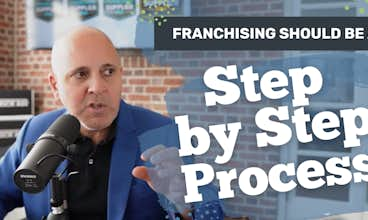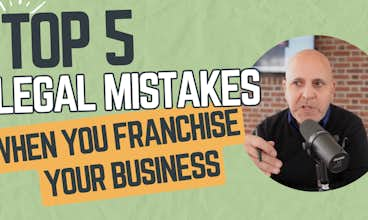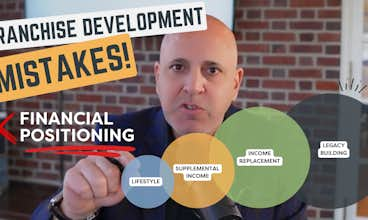Learn how to turn your restaurant into a franchise and find out how to go from restauranteur to franchisor.
In the restaurant industry, franchising is a proven method for achieving unit growth and expansion.
In the most recent data published by the U.S. Census Bureau, franchises represented over 54% of fast food and fast-casual restaurants in America. As the Census data is updated for 2022 and the restaurant industry recovers from the pandemic, we expect to see bigger trends with franchised eateries gaining even more market share in the restaurant industry.
If you’re a restaurant owner, founder or management team member considering franchising, this article can help you learn how to franchise your restaurant. Once you’ve determined that franchising is right for you, the steps for franchising a restaurant include:
- Franchise Disclosure Document (FDD) Development
- Operations Manual Development
- Protecting your Intellectual property
- Establishing your new franchising company
- Issue and Register your FDD
- Developing a Sales Strategy
- Develop a Franchise Plan and Budget.
Although we discuss each step in detail in our Ultimate Guide to Franchising Your Business, below we discuss the concepts behind franchising a restaurant.
Franchise Assessment – Should You Franchise Your Restaurant?
Before making the leap into restaurant franchising, it’s important to ask yourself whether or not it’s right for you. A good place to start is by evaluating the five franchisability factors:
- Is your restaurant successful?
- Is your restaurant scalable?
- Is your brand protectable?
- Are you committed to building a franchise system?
- Do you have the right franchise budget?
If your answers to the questions above are “yes,” franchising could be a good option for you.
Now, take a few moments to assess your situation and determine your goals for expanding your business.
Multi-unit restaurant expansion is achieved either organically, where you build-out, grow and manage multiple restaurant locations with your own funding or with the backing of investors and private equity,, or through franchising where you achieve growth through unit expansion that is funded, managed and operated by franchisees.
There are advantages and disadvantages to each form of expansion, and there are many examples of success. For example, multi-unit restaurant brands like Chipotle, Starbucks and In-N-Out Burger are company-owned and controlled but are not franchises, while restaurant brands like McDonalds, Dunkin' Donuts and Jersey Mikes are franchised outlets and examples of franchise success.
Once you’ve determined that franchising is right for your business, and you’ve taken the time to decide which type of expansion matches your budget and goals, it’s time to evaluate the steps of the franchising process.
Step 1: Prepare Your Franchise Disclosure Document
The Franchise Disclosure Document (FDD) is the legal prospectus that you will be required to issue and disclose to prospective franchisees as a franchisor before you can sell a franchise.
The FDD will provide a summary of your entire franchise offering, including details about your restaurant and management team, operational requirements, estimated start-up costs for establishing a restaurant, franchise, royalty and other fees will be paid to you, that legal relationship between you and your future franchisees, territory protection, and financial information about the historical performance of your current restaurant(s).
Step 2: Prepare Your Franchise Operations Manual
The franchise operations manual is the confidential manual that you will provide to your restaurant franchisees. It’s the how-to guide for developing and operating your franchise system and will include information about standards and requirements for developing a restaurant location, pre-opening training, menu recipes and standards, approved suppliers and vendors, marketing, maintaining front of house operations, maintaining back of house operations, rules for take-out, delivery, and catering, systems for dealing with app based ordering and third-party delivery services, and many other system standards.
Operations manuals will evolve and change over time as you improve, supplement and modify system standards.
Step 3: Protect your Intellectual Property
When you grant a franchise, one of the most valuable assets that you are conveying to your franchisees is a limited license to use your trademarks. A major step in franchising your business will include reviewing your trademarks, making sure they’re protectable, and registering them with the U.S. Patent and Trademark Office.
Step 4: Establishing a New Franchising Company
Although you have an existing business and, most likely, an existing company or LLC, when you franchise you will also be establishing a new franchise company, i.e., XYZ Restaurant Franchising, LLC.
There are many reasons for doing this, but the most basic one is to limit and confine your future franchise business from your existing restaurant operations. By doing this, within your FDD you will be required to disclose financial statements for this new corporate entity and not the financial statements for your current restaurant operations.
Step 5: Issue and Register your FDD
Once your FDD is complete and your team and franchise lawyers have developed a franchise system and offering that is legally compliant and that competitively positions your brand, it’s time to issue your FDD and, within the franchise registration states, register your FDD.
Issuance is a self-certifying process where your franchise lawyers complete the preparation of your FDD, determine that it complies with franchise laws, and put an issuance date on your FDD.
Once your FDD is issued, you can start offering and selling franchises in the non-registration states (i.e., states that do not require a special filing or registration) and file your FDD for registration in the registration states. Prospective franchisors can learn more by visiting our guide to state-by-state franchise filing and registration requirements
Step 6: Develop a Franchise Sales Strategy
During the franchise development process, it’s important to plan out a franchise sales strategy. Far too often, startup restaurant franchises waste money on marketing that they are not yet ready for. Franchise brands need to “season,” and so should your marketing strategy.
During the launch of your restaurant franchise we recommend focusing on developing a franchise sales landing page that tells your brand story and is focused on the value proposition that your restaurant franchise can provide to the right franchisee – that is, how can a franchisee transform and improve his or her life by establishing their own franchised restaurant location?
You’ll also want to focus on building organic leads comprised of qualified individuals and customers who are familiar with your restaurant and may be interested in buying a franchise, and conducting limited public relations focused on third-party storytelling that creates reusable content about your restaurant, your story, how your brand can transform the lives of your franchisees.
As a franchisor, it will also be important to provide prospective franchisees with overall validation – that is, documented evidence of your brand’s proven track record of success and financial strength over time.
Most importantly, as you’re working to develop your franchise strategy, make sure to focus on empowering yourself and your team to learn franchising and educate yourself about various franchise marketing channels, franchise vendors, events and organizations. Check out our free industry leading learn franchising webinars to learn more.
Step 7: Develop a Franchise Plan and Budget
Franchise success requires a five-year planning strategy. By creating annual plans that focus on specific goals and building on the previous year as your franchise system grows, you’ll be able to track and manage your franchise system’s success over time.
- Year 1:
Organic expansion, selling to a few well-qualified franchisees and “seasoning” your brand. - Years 2 to 3:
More sales, assisting and supporting franchisees in their growth, training, leveraging digital media and marketing including, organic lead generation, SEP, public relations and broker relations. - Years 3 to 4:
Focusing on accelerated franchise growth and the success and satisfaction of your existing restaurant franchisees (i.e., the franchisees you sold to in years one and two) will be critical to your future success during these years. If your existing franchisees validate your brand, are earning money and, potentially, achieving a good return on investment, they will provide important validation for future franchisee recruitment. You’ll also want to build up your marketing and social media presence, and focus on building momentum for your franchise system. - Years 4 to 5:
Focus on accelerated franchise growth, franchisee validation, positive cash flow, continued support of franchisees, and interest from private equity for reinvestment into your franchise system to support future expansion.
You can learn more about budgeting and planning in our “How Much Does it Cost to Franchise Your Business?” article.








